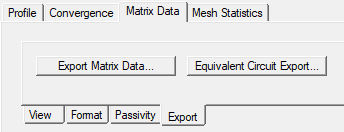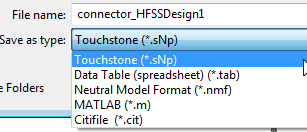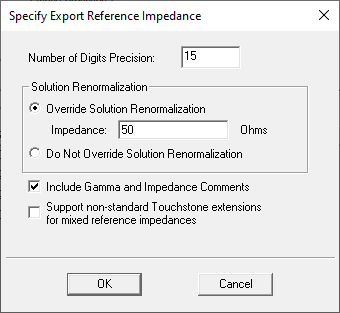Exporting Matrix Data
- In the project tree, right-click the solution setup of interest, and then click Matrix Data on the shortcut menu.
The Solution Data window appears. The Matrix Data tab is selected. You can also access the Solution Data window from the Results tab on the ribbon by clicking the Solution Data icon.

- Select the type of matrix you want to view: S-matrix, Y-matrix, Z-matrix, Gamma, or Zo(characteristic impedance.)
- Select the Export tab and click Export
Matrix Data.

A file browser appears.
- Type the name of the file you are exporting to in the File name text box.
- Select one of the following file formats from the Save
as type drop-down menu:

Format
Type
Description
(spreadsheet)
*.tabA text file in which the elements of the S-matrix are arranged in a series of columns that are tab-separated and include a first row of headings. The file may be imported into a spreadsheet or similar utility.
A Touchstone S-parameter file in which the number of ports is indicated by n. For example, a Touchstone file with one port would have the file extension .s1p. When you export this format, you are presented with a dialog.

You can specify:
- Number of Digits Precision (Default 15)
- Override Solution Renormalization. This refers to overriding the renormalization impedances that may have been asked for in the port setup. If so, the export renormalizes impedance
- Do Not Override Solution Renormalization. This leaves any port setup renormalization options in place, and grays out the Impedance setting on the dialog.
- Include Gamma and Impedance Comments
- Support for non-standard Touchstone extensions for mixed reference impedances. Writing gamma and Z0 is not Touchstone standard, but rather an HFSS "feature" that only HFSS will recognize.
If you want to export raw S-Parameter data for later use, you may choose to not renormalize the solution.
If all ports and associated modes/terminals are normalized to the same impedance and you choose Do Not Override Solution Renormalization during export, the Touchstone file header will indicate the normalized impedance.
The comment header in the Touchstone file lists the port and mode numbers to show which column contains which port name (in case of confusion between alphabetical and force repriority ordering of ports and associated modes).
! Touchstone file exported from HFSS 2024.2
! File: D:/Program Files/AnsysEM/v242/Win64/Examples/HFSS/Signal Integrity/package.aedt
! Generated: 1:56:02 PM Apr 01, 2020
! Design: HFSSDesign1
! Project: package
! Setup: Setup1
! Solution: Sweep1
!
# GHZ S MA R 50.000000
! Terminal data exported
! Port[1] = P01__NET179__T1
! Port[2] = P02__NET178__T1
! Port[3] = P03__NET178__T1
! Port[4] = P04__NET179__T1
Neutral Model format
Neutral Model file format defined by the MAFET Consortium. When you save to this format, if the design includes variables, you are presented with the NMF Parameters dialog that lets you select which variables to select as parameters in the NMF file. Non-selected variables will be give the constant value shown.
You are then presented a dialog that lets you specify the number of digits precision for the renormalizing impedance.
*.m
MATLAB
The Mathworks' MATLAB file in which the elements of the S-, Y-, or Z-matrix are arranged in a series of rows. Matlab only allows creation of complex numbers by specifying real and imaginary parts, not by specifying magnitude and phase.
*.cit
Citifile
Common Instrumentation Transfer and Interchange file format. It is an ASCII format defined by instrument and CAE designers.
For Touchstone files, you no longer see a Combine Sweeps option on the Export Network Data solution dialog box. This is because the current Sweep setup allows you to define multiple sweeps for a single simulation, meaning any needed combining is defined with the sweep setup.
- Click Save.
The data is exported to the file.
- By default, wave ports are listed in alphabetical, then numerical order, just as they appear in the excitation tree. You can change this order to creation order and back without invalidating the solution on the HFSS Options dialog box.
- If you select Touchstone format, you are first presented with a dialog in which you can specify the Number of Digits precision, and Override the Solution Renormalization. If so, you can specify the export renormalizing impedance (an integer value). Here you also can specify and whether to include Gamma and Impedance Comments, and Number of Digits Precision (Default 15).
- If you select Neutral File Format, you are presented
with a Specify Export Renormalizing Impedance dialog that lets
you specify the Number of digits precision for the save file.
Note:
If you modify the display of solved frequencies in an Interpolating or Fast sweep under the Matrix Data tab (by clicking Edit Freqs and then modifying the values in the Edit Sweep dialog box,) only those frequencies listed will be exported to the file.
